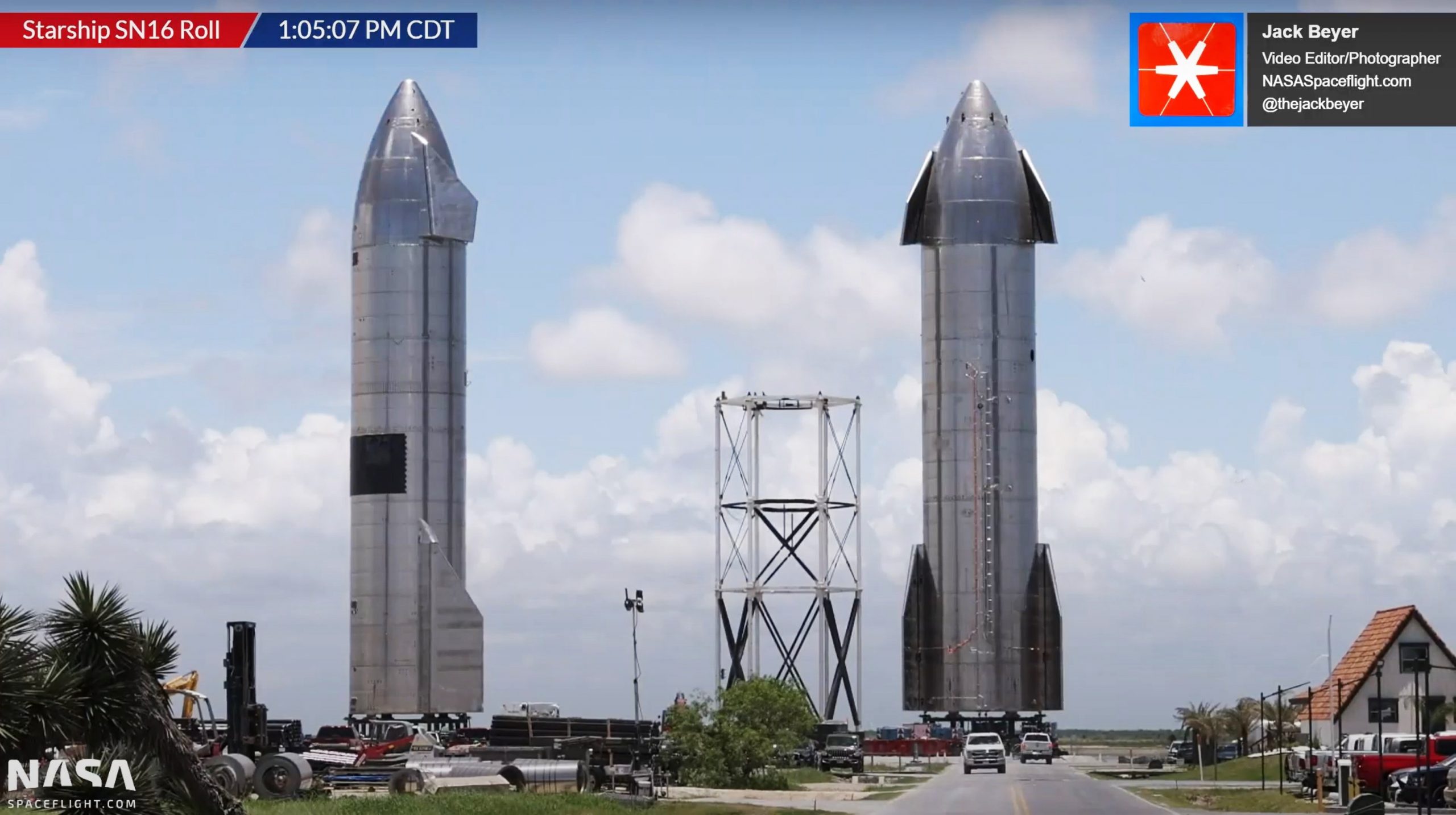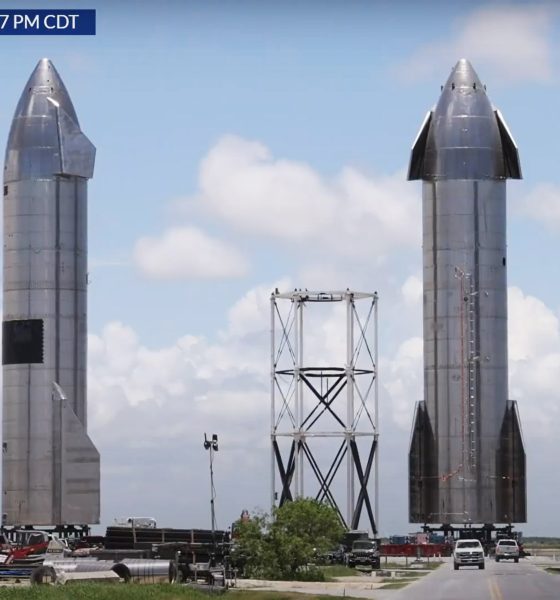

News
[Update: not so fast…] SpaceX retires brand new Starship to focus on orbital launch buildup
SpaceX has moved its newest finished Starship straight from its Boca Chica, Texas factory to a nearby ‘rocket garden,’ all but guaranteeing an early retirement.
Built as the first of several planned backups to Starship SN15, which debuted a number of significant upgrades in April and May, it appears that Starship serial number 16 (SN16) has been retired to a display stand after its only sibling became the first full-size prototype to successfully survive a launch and landing on May 5th. SN16 actually reached its full height before SN15 lifted off and was more or less complete by May 10th. Since then, the prototype has remaining more or less untouched, seemingly waiting for SpaceX to decide its fate in lieu of Starship SN15’s major success.
Ultimately, with SN16 now sitting side by side with SN15 at what will likely become a sort of open-air SpaceX museum, it appears that the company has made up its mind.
Once SN15 touched down, safed itself, and remained standing after a near-flawless 10 km (6.2 mi) test flight, questions about Starship SN16’s fate almost immediately arose. From the outside looking in, replicating that spectacular success was judged a logical next step by many in light of the four variously unsuccessful Starship launches that closely preceded it. If SpaceX could land SN15 and then successfully recover an entirely separate Starship weeks later, it would all but eliminate the possibility that – much like several different failure modes popped up on SN8 through SN11 – the first total success was a fluke.
Given that SN16 was quite literally completed within days of SN15’s launch and landing, it seemed an almost foregone conclusion that SN16 would fly. For a few weeks, it even looked possible that SpaceX would attempt to reuse Starship SN15. However, SpaceX appeared to decide against reuse and rolled its first flight-proven full-size Starship from the pad to a plot of land expected to host a future ‘garden’ for retired SpaceX rockets.
After its three intact flight-proven Raptor engines – valuable in their own right – were removed, Starship SN15 was seemingly retired around May 26th. Three weeks later, SN16 has (quite literally, to an extent) followed in SN15’s footsteps, bowing to an apparently virulent desire within (or at least atop) SpaceX to launch Starship into space and orbit as quickly as possible. From that perspective, assuming enough data was gathered by Starship SN15 to encourage significant confidence that its survival wasn’t an ‘accidental success,’ reusing Starship SN15 or flying Starship SN16 would only really benefit a line of prototypes that had just made itself obsolete.
Much like Starship SN15 debuted “hundreds of improvements” across the board, CEO Elon Musk revealed that Starship SN20 would also involve a “major technology [revision]” to produce the first prototypes with full heat shields, a stage separation mechanism, vacuum-optimized Raptor engines, and more. In fact, that process may still be ongoing, which could explain why SpaceX has yet to begin assembling Starship SN20 – various subsections and components of which have already been completed in Boca Chica.
Confirmed by Musk in March, SpaceX has been working towards a target of no later than July 2021 for Starship’s first orbital test flight. Given that Starship SN20 has yet to enter the assembly phase and that Super Heavy “Booster 2” (BN3) will be the first of its kind and likely need to pass several major tests on its own, July is no longer within reach. Of course, an orbital launch attempt anytime in 2021 would still be a staggering achievement for SpaceX, beating the likes of Vulcan Centaur, New Glenn, and Ariane 6 to the punch despite Starship’s superior performance, unprecedented design challenges, and grander ambitions.

News
Tesla starts showing how FSD will change lives in Europe
Local officials tested the system on narrow country roads and were impressed by FSD’s smooth, human-like driving, with some calling the service a game-changer for everyday life in areas that are far from urban centers.

Tesla has launched Europe’s first public shuttle service using Full Self-Driving (Supervised) in the rural Eifelkreis Bitburg-Prüm region of Germany, demonstrating how the technology can restore independence and mobility for people who struggle with limited transport options.
Local officials tested the system on narrow country roads and were impressed by FSD’s smooth, human-like driving, with some calling the service a game-changer for everyday life in areas that are far from urban centers.
Officials see real impact on rural residents
Arzfeld Mayor Johannes Kuhl and District Administrator Andreas Kruppert personally tested the Tesla shuttle service. This allowed them to see just how well FSD navigated winding lanes and rural roads confidently. Kruppert said, “Autonomous driving sounds like science fiction to many, but we simply see here that it works totally well in rural regions too.” Kuhl, for his part, also noted that FSD “feels like a very experienced driver.”
The pilot complements the area’s “Citizen Bus” program, which provides on-demand rides for elderly residents who can no longer drive themselves. Tesla Europe shared a video of a demonstration of the service, highlighting how FSD gives people their freedom back, even in places where public transport is not as prevalent.
What the Ministry for Economic Affairs and Transport says
Rhineland-Palatinate’s Minister Daniela Schmitt supported the project, praising the collaboration that made this “first of its kind in Europe” possible. As per the ministry, the rural rollout for the service shows FSD’s potential beyond major cities, and it delivers tangible benefits like grocery runs, doctor visits, and social connections for isolated residents.
“Reliable and flexible mobility is especially vital in rural areas. With the launch of a shuttle service using self-driving vehicles (FSD supervised) by Tesla in the Eifelkreis Bitburg-Prüm, an innovative pilot project is now getting underway that complements local community bus services. It is the first project of its kind in Europe.
“The result is a real gain for rural mobility: greater accessibility, more flexibility and tangible benefits for everyday life. A strong signal for innovation, cooperation and future-oriented mobility beyond urban centers,” the ministry wrote in a LinkedIn post.
News
Tesla China quietly posts Robotaxi-related job listing
Tesla China is currently seeking a Low Voltage Electrical Engineer to work on circuit board design for the company’s autonomous vehicles.

Tesla has posted a new job listing in Shanghai explicitly tied to its Robotaxi program, fueling speculation that the company is preparing to launch its dedicated autonomous ride-hailing service in China.
As noted in the listing, Tesla China is currently seeking a Low Voltage Electrical Engineer to work on circuit board design for the company’s autonomous vehicles.
Robotaxi-specific role
The listing, which was shared on social media platform X by industry watcher @tslaming, suggested that Tesla China is looking to fill the role urgently. The job listing itself specifically mentions that the person hired for the role will be working on the Low Voltage Hardware team, which would design the circuit boards that would serve as the nervous system of the Robotaxi.
Key tasks for the role, as indicated in the job listing, include collaboration with PCB layout, firmware, mechanical, program management, and validation teams, among other responsibilities. The role is based in Shanghai.
China Robotaxi launch
China represents a massive potential market for robotaxis, with its dense urban centers and supportive policies in select cities. Tesla has limited permission to roll out FSD in the country, though despite this, its vehicles have been hailed as among the best in the market when it comes to autonomous features. So far, at least, it appears that China supports Tesla’s FSD and Robotaxi rollout.
This was hinted at in November, when Tesla brought the Cybercab to the 8th China International Import Expo (CIIE) in Shanghai, marking the first time that the autonomous two-seater was brought to the Asia-Pacific region. The vehicle, despite not having a release date in China, received a significant amount of interest among the event’s attendees.
Elon Musk
Elon Musk and Tesla AI Director share insights after empty driver seat Robotaxi rides
The executives’ unoccupied tests hint at the rapid progress of Tesla’s unsupervised Robotaxi efforts.

Tesla CEO Elon Musk and AI Director Ashok Elluswamy celebrated Christmas Eve by sharing personal experiences with Robotaxi vehicles that had no safety monitor or occupant in the driver’s seat. Musk described the system’s “perfect driving” around Austin, while Elluswamy posted video from the back seat, calling it “an amazing experience.”
The executives’ unoccupied tests hint at the rapid progress of Tesla’s unsupervised Robotaxi efforts.
Elon and Ashok’s firsthand Robotaxi insights
Prior to Musk and the Tesla AI Director’s posts, sightings of unmanned Teslas navigating public roads were widely shared on social media. One such vehicle was spotted in Austin, Texas, which Elon Musk acknowleged by stating that “Testing is underway with no occupants in the car.”
Based on his Christmas Eve post, Musk seemed to have tested an unmanned Tesla himself. “A Tesla with no safety monitor in the car and me sitting in the passenger seat took me all around Austin on Sunday with perfect driving,” Musk wrote in his post.
Elluswamy responded with a 2-minute video showing himself in the rear of an unmanned Tesla. The video featured the vehicle’s empty front seats, as well as its smooth handling through real-world traffic. He captioned his video with the words, “It’s an amazing experience!”
Towards Unsupervised operations
During an xAI Hackathon earlier this month, Elon Musk mentioned that Tesla owed be removing Safety Monitors from its Robotaxis in Austin in just three weeks. “Unsupervised is pretty much solved at this point. So there will be Tesla Robotaxis operating in Austin with no one in them. Not even anyone in the passenger seat in about three weeks,” he said. Musk echoed similar estimates at the 2025 Annual Shareholder Meeting and the Q3 2025 earnings call.
Considering the insights that were posted Musk and Elluswamy, it does appear that Tesla is working hard towards operating its Robotaxis with no safety monitors. This is quite impressive considering that the service was launched just earlier this year.








